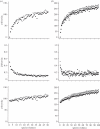Decomposing phylogenetic entropy into α, β and γ components
- PMID: 20961881
- PMCID: PMC3061168
- DOI: 10.1098/rsbl.2010.0769
Decomposing phylogenetic entropy into α, β and γ components
Abstract
Measuring the phylogenetic diversity of communities has become a key issue for biogeography and conservation. However, most diversity indices that rely on interspecies phylogenetic distances may increase with species loss and thus violate the principle of weak monotonicity. Moreover, most published phylogenetic diversity indices ignore the abundance distribution along phylogenetic trees, even though lineage abundances are crucial components of biodiversity. The recently introduced concept of phylogenetic entropy overcomes these limitations, but has not been decomposed across scales, i.e. into α, β and γ components. A full understanding of mechanisms sustaining biological diversity within and between communities needs such decomposition. Here, we propose an additive decomposition framework for estimating α, β and γ components of phylogenetic entropy. Based on simulated trees, we demonstrate its robustness to phylogenetic tree shape and species richness. Our decomposition fulfils the requirements of both independence between components and weak monotonicity. Finally, our decomposition can also be adapted to the partitioning of functional diversity across different scales with the same desirable properties.
Figures

 : mean local phylogenetic diversity estimated on local communities; Hβst: phylogenetic turnover.
: mean local phylogenetic diversity estimated on local communities; Hβst: phylogenetic turnover.
 )), β- and γ-diversity values were calculated on pairs of communities composed of one 20-species community and one n-community (n ranging from 1 to 50 or 1 to 100 species depending on the regional tree size). β-diversity is expressed as the proportion of biological turnover (i.e. Hβst = 1 − [
)), β- and γ-diversity values were calculated on pairs of communities composed of one 20-species community and one n-community (n ranging from 1 to 50 or 1 to 100 species depending on the regional tree size). β-diversity is expressed as the proportion of biological turnover (i.e. Hβst = 1 − [ /Hγ]).
/Hγ]).Similar articles
-
Generalization of the partitioning of shannon diversity.PLoS One. 2014 Mar 6;9(3):e90289. doi: 10.1371/journal.pone.0090289. eCollection 2014. PLoS One. 2014. PMID: 24603966 Free PMC article.
-
A comparative test of phylogenetic diversity indices.Oecologia. 2008 Sep;157(3):485-95. doi: 10.1007/s00442-008-1082-2. Epub 2008 Jun 20. Oecologia. 2008. PMID: 18566837
-
Phylogenetic diversity metrics for ecological communities: integrating species richness, abundance and evolutionary history.Ecol Lett. 2010 Jan;13(1):96-105. doi: 10.1111/j.1461-0248.2009.01405.x. Epub 2009 Nov 9. Ecol Lett. 2010. PMID: 19903196
-
Measuring biodiversity to explain community assembly: a unified approach.Biol Rev Camb Philos Soc. 2011 Nov;86(4):792-812. doi: 10.1111/j.1469-185X.2010.00171.x. Epub 2010 Dec 14. Biol Rev Camb Philos Soc. 2011. PMID: 21155964 Review.
-
A unifying quantitative framework for exploring the multiple facets of microbial biodiversity across diverse scales.Environ Microbiol. 2013 Oct;15(10):2642-57. doi: 10.1111/1462-2920.12156. Epub 2013 Jun 4. Environ Microbiol. 2013. PMID: 23731353 Review.
Cited by
-
Quantifying phylogenetic beta diversity: distinguishing between 'true' turnover of lineages and phylogenetic diversity gradients.PLoS One. 2012;7(8):e42760. doi: 10.1371/journal.pone.0042760. Epub 2012 Aug 17. PLoS One. 2012. PMID: 22912736 Free PMC article.
-
A guide to phylogenetic metrics for conservation, community ecology and macroecology.Biol Rev Camb Philos Soc. 2017 May;92(2):698-715. doi: 10.1111/brv.12252. Epub 2016 Jan 20. Biol Rev Camb Philos Soc. 2017. PMID: 26785932 Free PMC article.
References
-
- Mace G. M., Gittleman J. L., Purvis A. 2003. Preserving the tree of life. Science 300, 1707–170910.1126/science.1085510 (doi:10.1126/science.1085510) - DOI - DOI - PubMed
-
- Hardy O. J. 2008. Testing the spatial phylogenetic structure of local communities: statistical performances of different null models and test statistics on a locally neutral community. J. Ecol. 96, 914–92610.1111/j.1365-2745.2008.01421.x (doi:10.1111/j.1365-2745.2008.01421.x) - DOI - DOI
-
- Faith D. P. 1992. Conservation evaluation and phylogenetic diversity. Biol. Conserv. 61, 1–1010.1016/0006-3207(92)91201-3 (doi:10.1016/0006-3207(92)91201-3) - DOI - DOI
-
- Faith D. P. 2008. Threatened species and the potential loss of phylogenetic diversity: conservation scenarios based on estimated extinction probabilities and phylogenetic risk analysis. Conserv. Biol. 22, 1461–147010.1111/j.1523-1739.2008.01068.x (doi:10.1111/j.1523-1739.2008.01068.x) - DOI - DOI - PubMed
-
- Weikard H. P., Punt M., Wesseler J. 2006. Diversity measurement combining relative abundances and taxonomic distinctiveness of species. Divers. Distrib. 12, 215–21710.1111/j.1366-9516.2004.00069.x (doi:10.1111/j.1366-9516.2004.00069.x) - DOI - DOI
MeSH terms
LinkOut - more resources
Full Text Sources

